
 The newsletter of NASA's Radio JOVE Project
The newsletter of NASA's Radio JOVE Project"Solar and Planetary Radio Astronomy for Schools"

 The newsletter of NASA's Radio JOVE Project
The newsletter of NASA's Radio JOVE Project

First-time attendee, Cassandra Witiver, shares her impressions of going to the Society of Amateur Radio Astronomers (SARA) / Radio JOVE joint conference that was held at the Greenbank radio observatory this July. - Editor
Isolated. I have no other way to describe the National Radio Astronomy Observatory. Though, that particular word has a rather negative connotation. In this case it’s nowhere near being negative. Actually, it’s probably the best word I could use because good, precise radio astronomy demands it and so does the human psyche to a point.
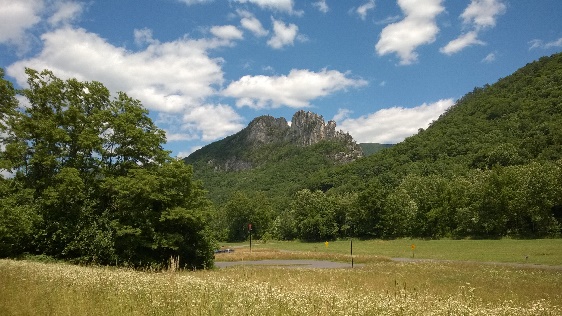
This was my first time driving from Maryland by myself to another state, let alone West Virginia. The first sixty miles felt like the longest sixty miles of my life. I obviously didn’t know what long meant as I had yet to experience it. Once I got into Virginia I learned. The twisty mountain roads were terrifying (mostly because it was my first time driving in the mountains) and a slow slog through rain. However, about thirty miles from the NRAO the sun came out and I was on what seemed to be perpetual downward grade which made it significantly easier to keep on.
Pulling into the NRAO complex around six in the evening was the most relieving experience I’ve had all year. I had finally made it the two hundred and forty miles from Maryland.
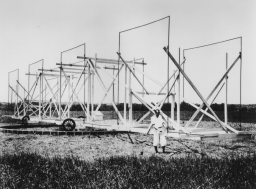
As I was trying to find a place to park I passed a large group of people out on the lawn. They were all grouped around two or three radio antennae that were set up by the Jansky antenna. And until then I didn’t really think of the fact that I didn’t know anybody that was going to be attending the conference. However, that soon changed after having received my name badge. I was introduced to the entire cast of people attending the SARA meeting by Bill Lord. They were wrapping up the meeting and Bill looked straight at me and said, “You, what are you doing here?” Or at least that’s how I remember it. My heart stopped when he asked me that. He then motioned for me to stand up which also scared me. Keep in mind that I technically wasn’t supposed to be participating at all at that point as I had arrived a day early. So, I (very nervously) said what I was doing there and I don’t think that anyone at the conference didn’t recognize my face after that. No matter how terrifying it was it helped me greatly.
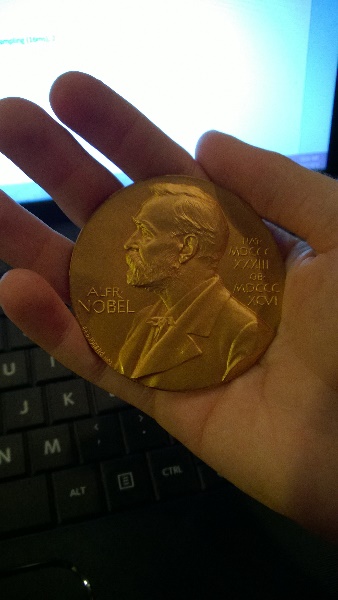
Not only was this my first long drive, but this was my first conference. And there’s something to be said for firsts. Sometimes they’re good, sometimes they’re weird, and sometimes they’re bad. However, they’re always remembered. This one in particular was rather magnificent I think. I met a ton of people whom I really enjoy and I met a few people I will probably remember forever. And to me that’s what made this such a wonderful and valuable experience. I also learned a great deal. I walked into the conference with a very base knowledge of the Jove program and Radio-Skypipe. The talks were extremely thorough, well thought out, educational, entertaining, and on a very appropriate level. There were some which were on a more popular level and others that weren’t, but they were presented in such a way that the higher level talks expanded on the lower level ones. In that vein, the speaker that I liked most had to have been Dr. Joe Taylor who just happened to be a Nobel Laureate. He gave a very informative (though less detailed than I had wished) talk on pulsars and his research with them. Happily enough though, he pitched his power point and the notes that go with it into the flash drive that Dr. Higgins has put together for a meager sum of $15.00 a drive. Also, this cannot go without mentioning, Dr. Taylor passed his Nobel medal around the room. That had to be number two on my list of magnificent things that happened at the conference.
Number one on my list is rather mundane (or at least I imagine it is) to most astronomers. My number one was actually seeing the Milky Way for the first time in my life. It was perhaps one of two times in my entire life that I’ve come anywhere near a religious experience. I was rooming out in the Rabbit Patch which is NRAO employee housing and there are no lights anywhere near there. I was going back to my room the very first night and I didn’t even think about looking up until I got to the house which is my usual mode of operation. Whenever I drive anywhere the first thing I do when I get out of my car is look up. So, that’s what I did and I was just stunned. There’s really no other way to describe the experience as anything but profound. I had never seen anything so beautiful in my entire life. It was so beautiful in fact, that it brought tears to my eyes. There’s just something about looking up into the center of the galaxy that makes one feel so small and so profoundly special. You’re seeing into our solar systems life blood. It’s the progenitor of humanity and so many people don’t even stop to look at it. And in that moment not only was I awed, but I pitied all the people on this planet who haven’t looked up and all the people who take the few stars they see for granted. Because, in that one moment I became spoiled.
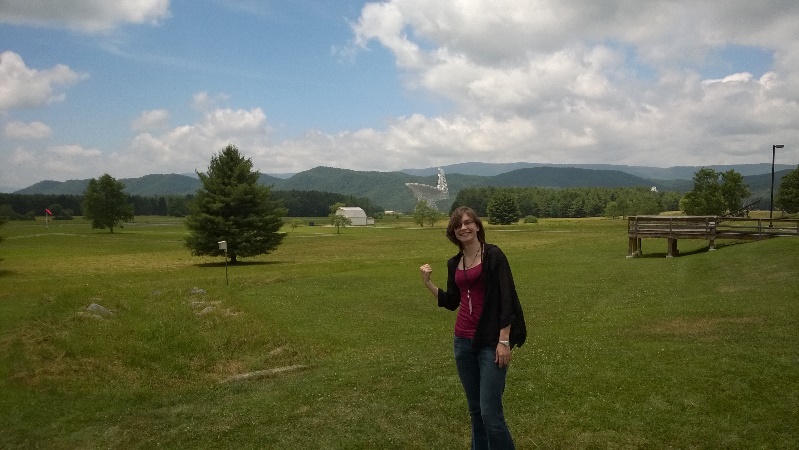
Believe it or not, seeing the GBT was actually number four on my list. That included and wasn’t limited to learning the history of the complex. Actually seeing where a beam from the 300 foot telescope pierced its control house was really very interesting being the history buff that I am. However, the Great Big Telescope was just that. Not particularly awe- inspiring and not particularly magnificent (unless you’re an engineering major). What interested me most about the GBT actually wasn’t that it was huge or pretty, but that it is a highly complex and precise instrument of discovery and learning. It can hone in on things that are parsecs away with a relatively small degree of error which I find absolutely amazing. The idea that we, as a collective of (intelligent?) creatures came up with this telescope that can gather data from hundreds of thousands of years ago is absolutely astonishing.
In any case, it only made number four on the list.
Number three however, was far more interesting. It turned out to be the conversations that I had. The most memorable that I had happened to occur while inside the control from for one of the 30 foot telescopes. We spoke of politics and fascinating things such as cultural beliefs that have spanned generations and those that have died with previous ones and those that develop as one ages. We spoke of idealism, and fascism, and socialism, and capitalism. We spoke of foreign leaders and the standards of “our” culture versus “theirs”. We spoke of the golden era of America and feminism.
If there is anything that I enjoy in my life more than science it would certainly be conversation. Sharing ideas and having a sense of community is a beautiful thing, for if we felt alone I fear none of us would have the courage to learn. And in speaking to people we do just that; learn. I learned a great deal via the conversations that I had. It might not all have been centered around science, but it was fun. And that’s what matters.
One doesn’t usually expect an optical telescope to be present at a radio astronomy conference and there wasn’t. However, I couldn’t pass up the chance to bring mine even though the weather forecast predicted it to be very cloudy all week. We wound up having quite a bit of fun with it even though it couldn’t find any deep space objects and it took an hour and a half to get aligned. It was a hit especially with the high school students that were on a field trip there.
Speaking of the high school students, SARA invited them into the presentations for Wednesday and on. They surprised me a lot not only in their behavior but in their interest in our content; so much so that it stood out greatly in the Q&A that Jim Thieman hosted at the end of the conference on Thursday. They posed some rather intelligent questions and brought a valuable perspective to the conference. Actually, I remember one of the kids posing a question specifically about z-bursts, for which there is yet to be a complete and accepted explanation. This simple question posed by one of the younger attendees of the conference lead to an hour and a half discussion on what may have caused this phenomenon. It was and is nice knowing that children are being encouraged to think critically about unanswered questions.
Overall, I had a really great experience at the conference and I honestly can’t wait to return next year. I also absolutely adored the locale and will most certainly be returning even if a meeting is not taking place. In addition, I met a number of wonderful people that I look forward to fostering relationships with throughout my career.
Communicating by amateur radio can be a great hobby but there are times when there is no substitute for direct face-to-face interaction. Recently there were two spring events in which Radio Jove partnered with the Society of Amateur Radio Astronomers (SARA) to have exhibit booths to advertise the scientific use of amateur radio equipment.
The first event was the USA Science and Engineering Festival which occurred at the Washington DC Convention Center from April 25th to April 27th. The festival was two years in the planning and it is amazing that the organizers can do it in just two years. There was no entrance fee and the estimated attendance for the Festival was 240,000! The SARA/Radio Jove booth was one of several thousand exhibits. The stream of people coming to the exhibit never seemed to stop so it was a great opportunity to advertise radio astronomy to people from all over the world. It will be another two years to the next Festival but mark your calendar now since it is a wonderful showcase to visit to learn about nearly anything related to science and engineering.
Every year in May the biggest gathering of radio amateurs in the world takes place at the Hamvention in Dayton, Ohio. This year the convention occurred from May 16th - 18th. SARA and Radio Jove again got together to advertise amateur radio astronomy to this very specialized crowd. Even though the purpose of the event is very particular it still attracts around 16,000 people. It is always interesting to pose the question to a radio ham passing by: “Have you ever considered doing radio astronomy?” Many have never thought about receiving radio signals from the Sun or Jupiter rather than distant colleagues. Interesting conversations ensue. We hope we have planted the seeds of scientific discovery in many people as a result.
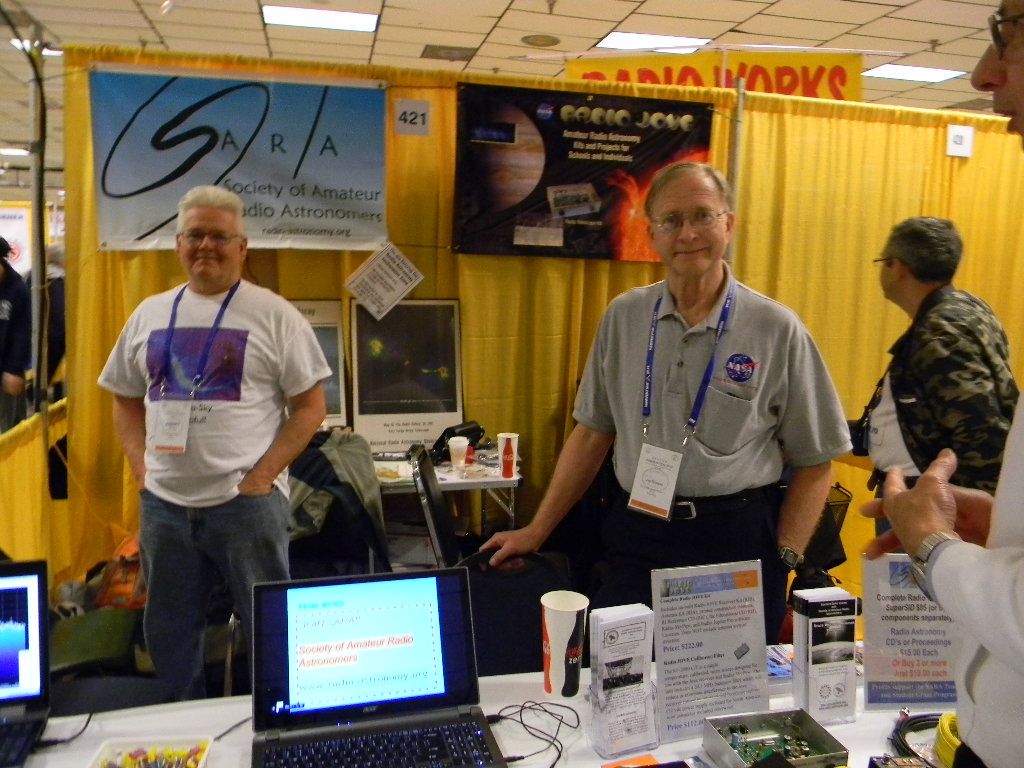
The students of Maharaja Surajmal Institute of Technology, New Delhi, India, as undergraduates had the opportunity of being exposed to something as widespread and worthy as the IEEE Student Branch’s Summer Grant Program. In 2013, 1st and 2nd year students from the Electronics and Communication Departments were introduced to Radio Astronomy and Astrophysics that helped them learn more about Universe. The motivation was to teach radio astronomy and astrophysics in a country where opportunities are not easily available and very few are able to take advantage of them. We are thankful to the Society of Amateur Radio Astronomers (SARA), our mentor Mr.Tushar Sharma currently at iRadio Labs, University of Calgary, Professor Shibn Koul , IEEE Delhi MTT Chapter, Professor Subramaniam Ananthakrishnan, Electronics Science Department, University Of Pune and the NASA Radio Jove Team members. Also we would like to thank our college Director Dr Navin Kapur, Dr Punam Bansal, Mrs Kavita Sheoran, Mrs Savita Ahelawat, Mr Praveen Kumar and Mr Manoj Malik for their help and support.
Under this summer program various projects were undertaken
including:
Students worked very hard with limited resources and equipment in completing these projects that started on 8th July and ended on 20th August and did so with great success. This is just the beginning. It is quite fascinating that apart from seeing the sun and other celestial bodies we can also hear them. There are constant blasts from the sun. Jupiter also radiates energy which reaches earth’s surface and can be studied using the Radio Jove system. We started our program by studying the basics of antennas (Dipole Antenna), radio waves, radiation from the sun and Jupiter and their effects on earth. Then came the practical application when we set up the fabricated antenna in a village situated on the outskirts of Delhi for taking readings from the sun and Jupiter. The locals were unaware of what we were doing which clearly reflects the need to popularize such scientific activities in India. The experience was indeed wonderful and full of learning. Doing such a wide project in MSIT has not only inspired the students currently studying there to widen their horizons and fly, but will continue to do so in coming years.
The students who earlier did not even know about such concepts are now more aware of the opportunities related to these fields if you are willing to learn and explore!
[Editor's Note: This group also conducted a similar program in January of this year for a new group of students. Congratulations!]
In 2010, we initiated the process to acquire, install and operate a JOVE radio telescope kit. In that time, we have completed a permanent installation, (featured in the June 2013 JOVE Bulletin), initiated a 24x7 data archiving program, and implemented a 24x7 live data feed under the server name “AACC Observatory”. Our upcoming goals include integration with our astronomy lab curriculum, and a 24x7 live audio feed.
We have done most of our observing remotely over the past few weeks, and we have also taken advantage of Skypipe’s ability to open multiple client windows in order to correlate our observations with other nearby observatories in real time. We have also found the Spectrograph program to be quite valuable as well for both detecting larger patterns and correlating data between multiple locations.
During our recent observations, we have detected a very interesting correlation between the Spectrograph feed from HNRAO in Industry, Pennsylvania and periodic high strength signals received by the JOVE antennas at both HNRAO and at our facility (AACC Observatory) in Arnold, Maryland. The two facilities are approximately 231 miles apart, indicating that these particular signals are not locally generated interference as we previously believed. In fact, the signal in question is visible on the Spectrograph feed from HNRAO as an upwardly sloping line which repeats periodically. As the signal increases in frequency, and passes the tuned frequency of the JOVE equipment, it is observable at our facility as a sudden spike in calibrated antenna temperature that quickly falls back to the background level. A similar spike was also observed on the JOVE antenna at HNRAO, and the three observations were correlated very closely in time, within approximately one second of each other or less at every observation. In total, we have detected this particular correlation approximately 10 times.
The screen shot below was taken at approximately 10:19 pm EST on May 14, 2014. The Skypipe feed (left) is from the AACC Observatory, and the Spectrograph feed (right) is from HNRAO. Unfortunately, the data file from HNRAO was not saved.
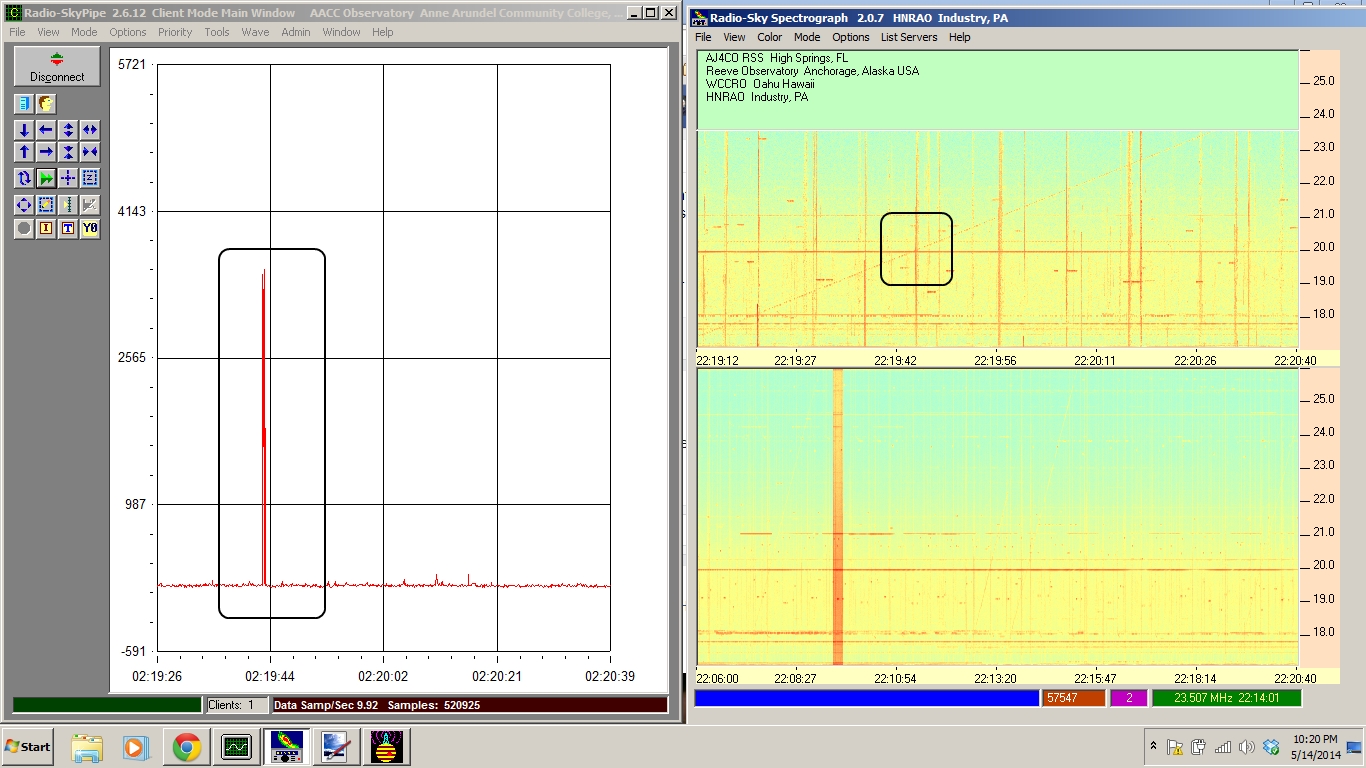
The next Jupiter observing season will start in the beginning of October 2014 and run through the beginning of May 2015. The diagrams below explain how this Jupiter observing season comes about. Jupiter emission varies smoothly from quite strong during opposition to very weak during conjunction. The dates given below are only rough guidelines to the part of the year in which watching for Jupiter is more profitable for an observer using the Jove dual dipole array. It is possible to observe stronger Jovian emission weeks or months into the off-season if the emission power is high enough to make up for the added propagation distance and thicker terrestrial ionosphere. Such occurrences are rare. Increased antenna gain can extend the length of the useful observing season by bringing weaker point-source Jovian signals further above the whole-sky-source galactic background. |
|
| View from North Ecliptic Pole |
View Looking Toward Southern Horizon |
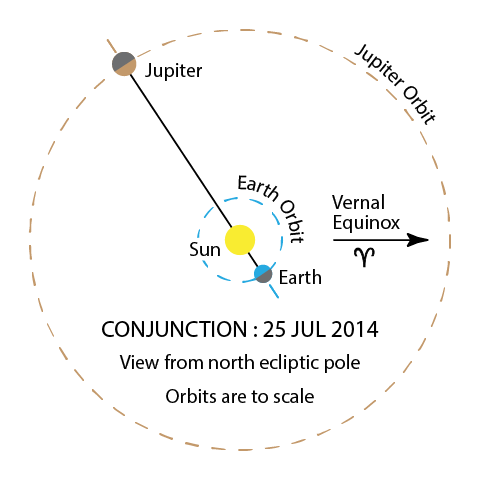 |
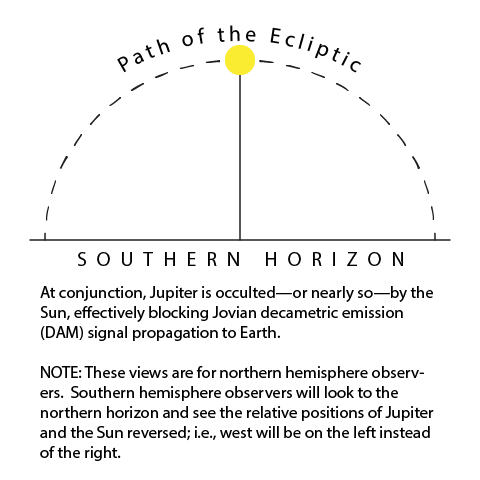 |
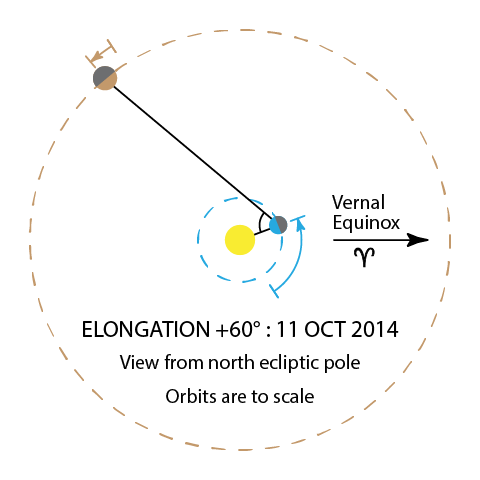 |
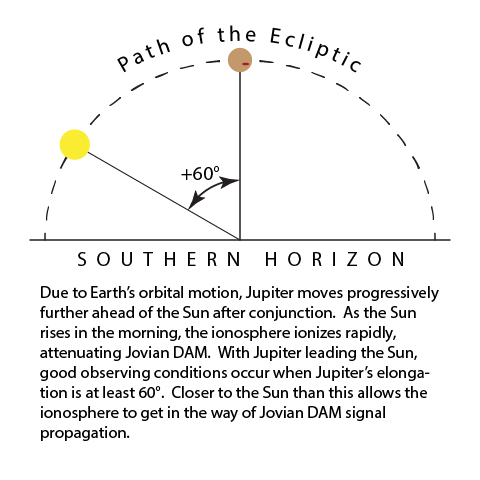 |
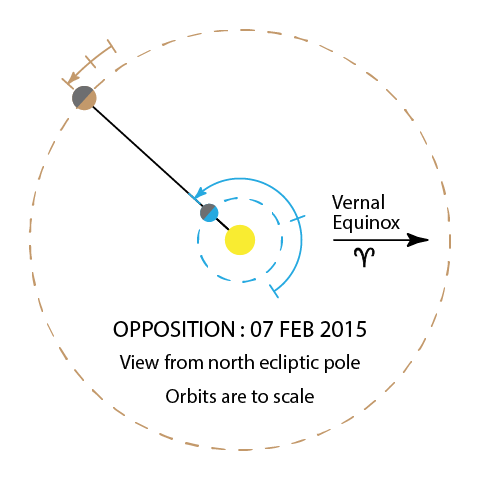 |
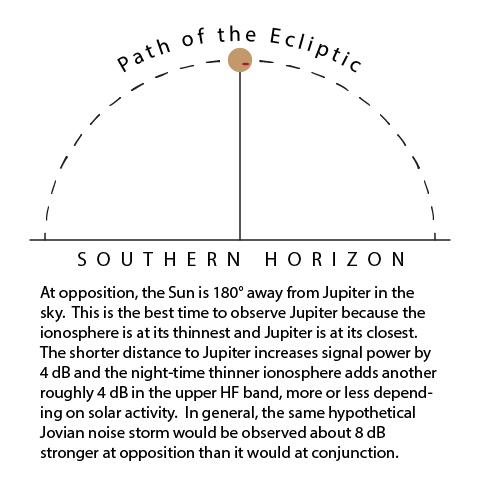 |
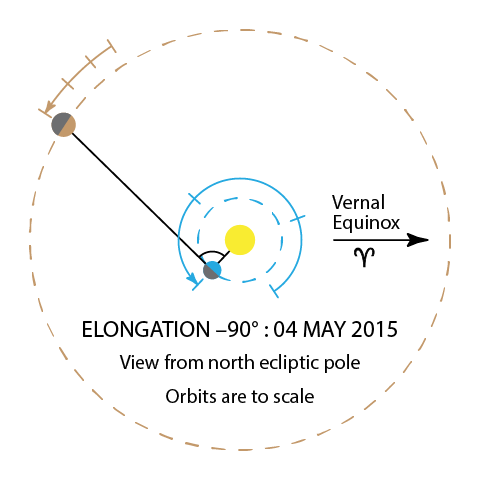 |
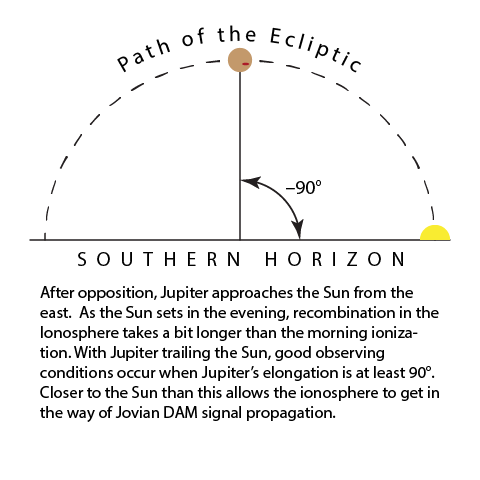 |
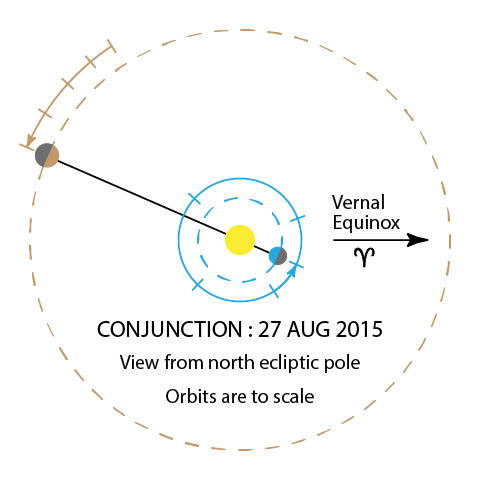 |
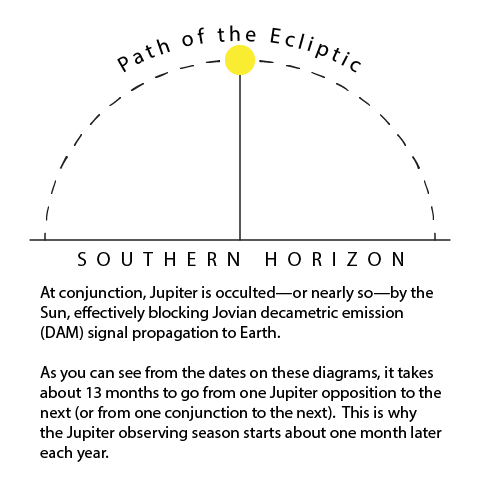 |
| A plot of Jupiter elongations from 2013 through 2015 is available on the SUG site at http://www.radiojove.org/SUG/Predictions/Jupiter Elongation 2013-2015.pdf |
|
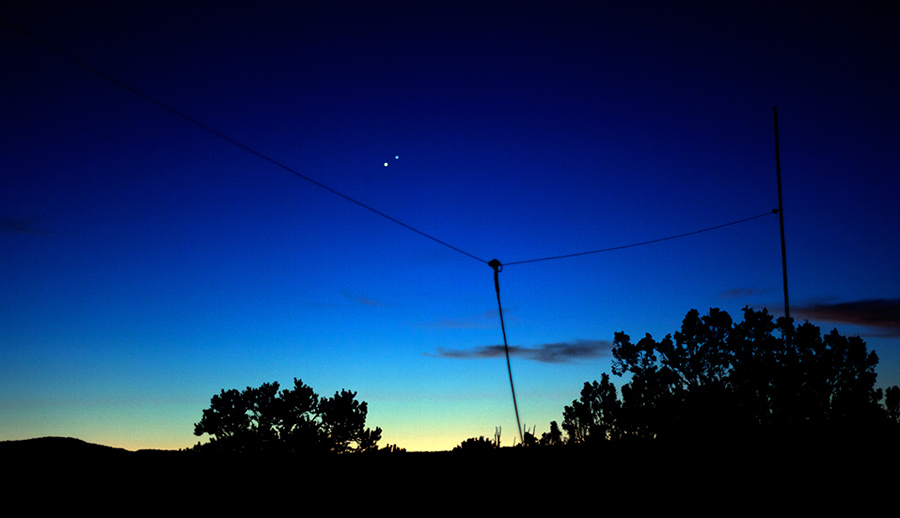
August 18, 2014. Jupiter and Venus at dawn.
The JOVE Bulletin is published twice a year. It is a free service of the Radio JOVE Project. We hope you will find it of value. Back issues are available on the Radio JOVE Project Web site, http://radiojove.gsfc.nasa.gov/
For assistance or information send inquiries to:
or
